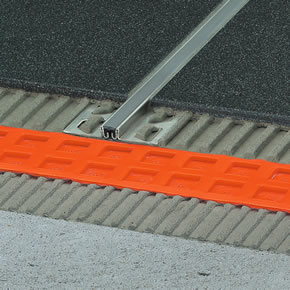
Movement joints developed to prevent damage to flooring
Schlüter explains how the correct specification of movement joints can prevent damage to tile coverings and stone flooring installations.
After installation, tile and stone flooring can often fail: variations in temperature and moisture can cause movement within subfloors, resulting in cracks. In some cases, this movement can weaken the bond between floor covering and substrate.
A lack of movement joints can be a contributing factor to failure. According to current industry standards and regulations, movement joints are required in all tile and stone installations to prevent such damage.
If an architect neglects to specify movement joints, they may be liable for any resulting problems; it is the responsibility of the architect to ensure that the appropriate type of joint is specified and installed in the correct location.
Specifying movement joints
 Movement joints must be designed at specification to ensure penetration through the tile and screed covering.
Movement joints must be designed at specification to ensure penetration through the tile and screed covering.
By understanding the types of movement that are likely to occur – such as moisture, thermal, structural and deflection movement, as well as dry shrinkage – architects will be able to specify a movement joint suitable for counteracting the resulting stresses.
In floors, there are two basic types of movement joints: structural and non-structural. Both will be subject to different movement patterns; they work to prevent damage differently.
The Schlüter-DILEX range of movement and expansion joints offers a range of solutions, suitable for all relevant movement joints in tile coverings.
Schluter-Systems
Units 3-5 Bardon 22
Beveridge Lane
Coalville
Leicestershire
LE67 1TE
UK
01530 813396
Visit the Schluter-Systems website
Visit Supplier's page
Latest news

8th April 2025
First look at industry speakers for GEO Business 2025
GEO Business, the UK’s premier geospatial event, is set to return to ExCeL London on 4 – 5 June 2025, bringing together the brightest minds in the industry.
Posted in Articles, Building Industry Events, Building Industry News, Building Products & Structures, Building Services, Exhibitions and Conferences, Information Technology, Innovations & New Products, Restoration & Refurbishment, Retrofit & Renovation, Seminars
8th April 2025
Digital Construction Week 2025 announces first wave of industry-leading speakers
Digital Construction Week (DCW), the UK’s premier event for digital innovation in the built environment, is set to return to ExCeL London on 4 – 5 June 2025.
Posted in Articles, BIM, Infrastructure & CAD Software, Building Industry Events, Building Industry News, Building Products & Structures, Building Services, Building Systems, Civil Engineering, Exhibitions and Conferences, Hard Landscaping & Walkways, Health & Safety, Information Technology, Innovations & New Products, Landscaping, Retrofit & Renovation, Seminars
7th April 2025
Abloy UK provides bespoke access control solution for CPA Group’s Lanarkshire HQ
Abloy UK has supplied CPA Group with its PROTEC2 CLIQ solution to streamline access control and protect assets at its headquarters in Shotts, Lanarkshire.
Posted in Access Control & Door Entry Systems, Architectural Ironmongery, Articles, Building Industry News, Building Products & Structures, Building Services, Case Studies, Doors, Facility Management & Building Services, Health & Safety, Restoration & Refurbishment, Retrofit & Renovation, Security and Fire Protection
7th April 2025
ASSA ABLOY EMEIA: A new generation of reader is added to the Aperio digital access family
There is now a way to control access digitally, effectively and wire-free, thanks to ASSA ABLOY EMEIA…
Posted in Access Control & Door Entry Systems, Architectural Ironmongery, Articles, Building Industry News, Building Products & Structures, Building Services, Doors, Facility Management & Building Services, Health & Safety, Information Technology, Innovations & New Products, Posts, Retrofit & Renovation, Security and Fire Protection
 Sign up:
Sign up: